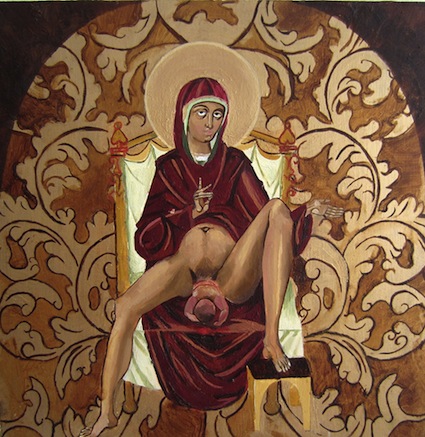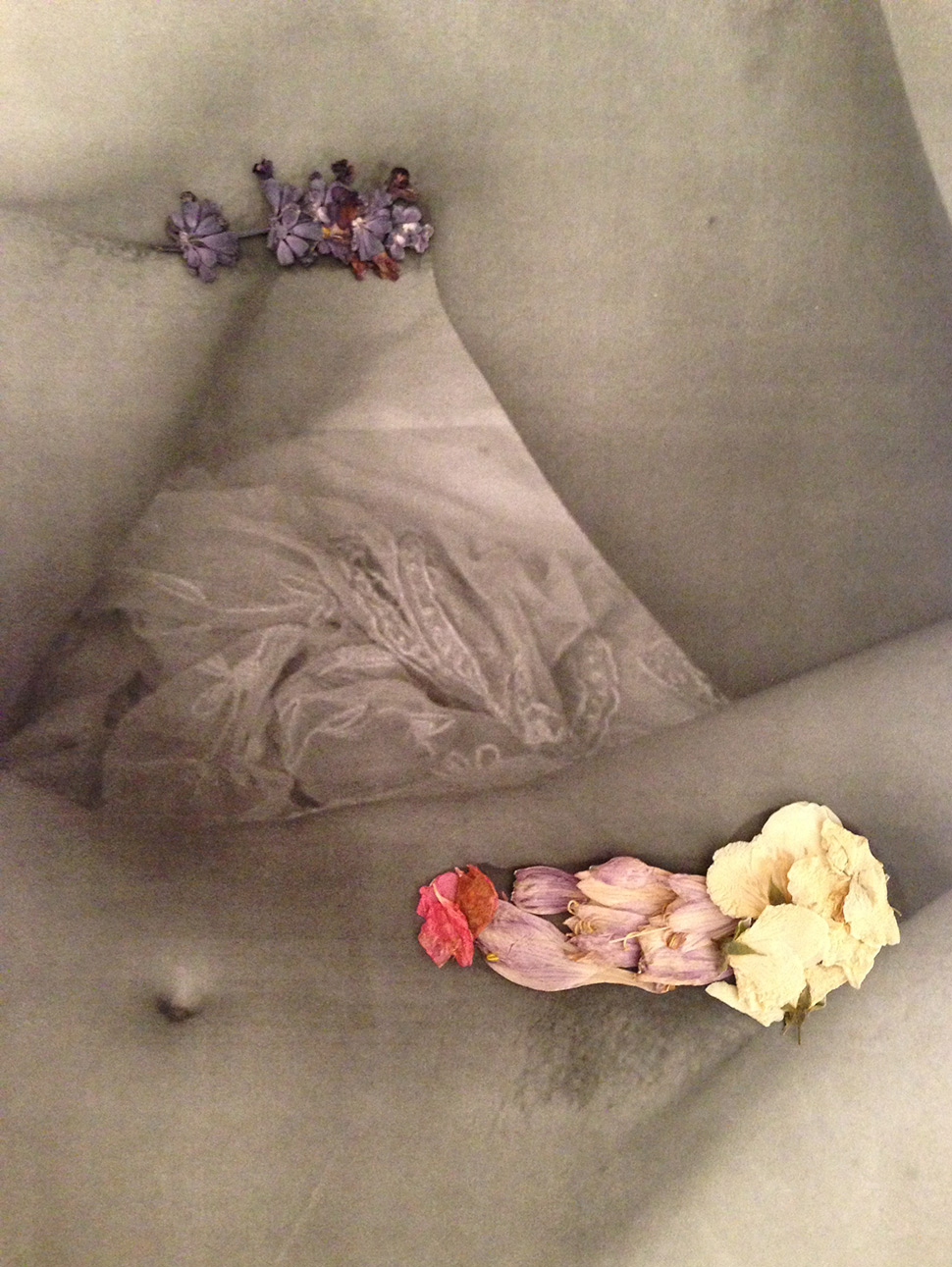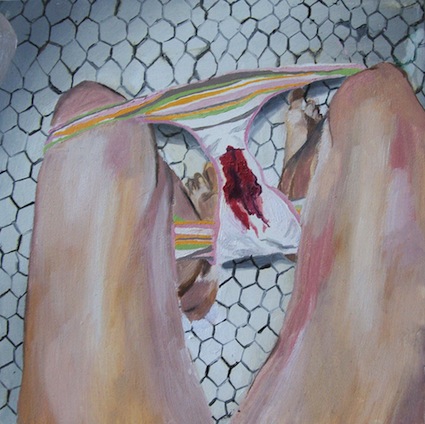q&a: feminist artist kelsey shwetz
Kelsey Shwetz is a Canadian-born feminist painter currently living in Queens and working in Chelsea, NYC. Shwetz received a BA Honours in Psychology and Painting in 2009. Her work has been exhibited in Montreal, Toronto, New York, India, Paris, and Costa Rica. Shwetz has also been featured in The Journal of Gender and Sexuality, Chesterfield Magazine, Lost at E Minor and Projekt 30. Her work has been cited in New York Manhattan | Examiner, Tjen Folket, and The Globe and Mail.
Can you outline a thematic context for your work?
In my work I challenge and subvert interpretations of gender norms, sexuality, fertility, and beauty; things which seem natural and automatic. I’m interested in addressing how these are mediated by a social context; also how the gender we identify as, the time period we live in, and our geographical location negotiate the experience of our bodies and the bodies of others.
Painting is a traditional medium that has historically been used to promote social ideals. Using the traditional framework of canvas, oil paint, and gallery, I present new and often not widely accepted concepts in an attempt to de-stigmatise and normalise them. Currently, I’m focussing on divinising and exalting biological processes (such as menstruation), and the expression of femininity outside the male gaze by presenting it in a classical way.
What notions of gender are at the basis of your work?
I view the experience and expression of gender and sexuality as very fluid, existing on a continuum versus a binary system. At the basis of my work is the assertion that society shapes our experience of sexuality and gender identification.
How did you become interested in gender as subject matter? Were there any specific thinkers, artists or experiences that inspired you to explore the theme further?
In fact, yes. When I moved to Montreal it was with my fiancée at the time –I had always been in monogamous, heteronormative relationships. We split shortly after moving there and this was when I met these wonderful, radical, feminist friends. One evening I was at a party, I was standing in the kitchen with two of these girls –who I had just painted together – when two other of our friends joined us and somehow we ended up together in bed. We had this beautiful expression of feminine love and care and sexuality and we all just felt so close afterwards. All of us differed in how we would classify our sexual orientation but yet we had this shared experience. Since then I’ve wanted to explore what gender and sexuality really mean.
Describe your style and method?
I would say I have two diverging styles and methods. The first is meticulous and careful – I’ve studied Renaissance oil glazing techniques and with this method a painting begins with a grid, then a drawing, then underpainting, then building each successive layer from there. It takes forever because each layer has to dry before you apply the next. I’m painting from photographs or sketches with this method since I find it a little unreasonable to ask a model to sit for that long. The second is painting alla prima, where you apply colours wet on wet. I’m much freer with these works, and since I almost always paint this way from life they are done much more quickly. The palette of these works is also less restrained, for instance I’m using phthalo blue, magenta, lemon yellow, light green, cadmium orange for highlights on breasts and dark circles under the eyes. This style is much more influenced by Expressionism.
Which artists have influenced you stylistically?
Henri Matisse and Lucien Freud most recently.
Where did you grow up? What experiences led you to become an artist?
I grew up in Winnipeg, which is a prairie city in central Canada. I hadn’t done much travelling until I went on the obligatory trip backpacking through Europe in University. Seeing Van Gogh’s works in person for the first time was life-altering. Seeing the brushstrokes he had made, seeing the canvas he touched and the paint he manipulated – that changed something. Growing up it was drummed into my head that being a painter wasn’t a viable career option. In Montreal I was subletting an apartment from a painter friend (he was doing his MFA at the time) and I remember waking up every day in this beautiful apartment with stained glass windows and seeing his art hanging on the walls and I just thought “fuck it! If he can do this and survive, why not I?”
In what ways do you think visual art can work as a tool to subvert dominant norms and preconceptions about gender?
Firstly I think it is important to recognise that visual art has historically been used as a way to promote ‘The Ideal’ – whether religious, aesthetic, social, or political. Because of this dynamic, we have been socialised to deem acceptable and even favourable the subject matter we see depicted in a painting, especially if that painting is visually appealing and hanging in a gallery. By painting subject matter and concepts that are inconsistent with prevailing norms or views about gender, I think we are able to normalise them.
What are the unique aspects of visual art as a form of communication – ie. what can it express that other forms of communication, such as language, cannot?
Language relies on the presupposition of some education and knowledge. In order to be affected by great writing, it must be in a language you can understand. I believe people’s relationship with colour, line, and form is more intrinsic and universal. If you have no prior art history knowledge you may still be moved by a piece of visual art, think about it for days after, and not really know why. Abstraction in visual art is also very interesting. It is incredible that we are able to discern an object in nature when it is represented by just a few of its characteristics.
Do you see art as a form of therapy and self-exploration? How much of your work is autobiographical?
It is self-exploration more than therapy for me. I would say all of my work is autobiographical because how could it not be? I have some sort of relationship with everyone I’ve ever painted and hope to continue to do so. The more I review my paintings as a cohesive body of work (now is the first time I’ve had a studio large enough to do this) I notice that I’ve intentionally or unintentionally preserved a period in my life. Who I’ve been in love with, sleeping with, influenced by, enraptured with, or norms I’ve felt particularly stifled by and had no other way to articulate and break through have all been transmitted to paint on canvas.
Historically, due to their exclusion from public life, women have predominantly been depicted as the ‘object’ or ‘muse’ of male painters – beautiful ornamental bodies rather than subjects of their own experience. Do you believe this has influenced the ways in which society has understood the female experience?
It has not influenced how all of society understands the female experience –every person who identifies as female can attest to experiencing more than reclining on sofas with half closed eyes and silken scarves draped over our vaginas. I think where this exclusion and depiction is problematic is when people who don’t identify as female create parameters that encase females in this very uni-faceted model, and then refuse to acknowledge any evidence that challenges or refutes this model. I don’t believe it was ever an issue for women to inherently doubt their capability to experience, understand, and affect the world in a way equal to men. However, what is very real, and still continues to be, is how society documents, mediates, and supresses our interactions, education, and power.
What interests and inspires you to express and explore themes of gender through your work? Why do you see it as important subject matter?
Gender is so inherently subjective. The gender I identify with and choose to express, how I interpret “femininity”, “masculinity” or “androgyny” can differ so greatly from another person that it almost becomes arbitrary. I am more interested in the behaviours and thoughts individuals have linked to gender expression, rather than gender as a way to differentiate or categorise people.
Your work is political and sometimes controversial (‘The Birth of Christ’ and ‘First Period’, for example). Do you feel it is important to address polemical issues through your work?
I feel it is important to depict things which we as women have been unjustifiably and unacceptably taught to be ashamed and embarrassed of. I felt it was important to paint that moment when a young girl is peeing and looks down and sees blood on her underwear for the first time (‘First Period’). This is an emotionally charged, significant, divine, and beautiful moment. I felt it was important to paint it in ice cream colours, to make it somehow delicious and pretty and for many people of every gender to see it and think about it and talk about it.
Have you ever faced criticism or resistance to the themes you choose to present? If so, how have you dealt with this?
I have. My initial reaction is to try to understand what aspects of the particular piece a person finds offensive or unsavoury. If a person finds menstrual blood or an erection or a foetus crowning offensive, I want to understand why. I want to open a dialogue with them.
A lot of your work is based on sexuality and the female form as an important ‘site’ to investigate gender. In what ways do you think exposure to and exploration of the female body can influence ideas about gender?
I wish I had a more complex answer for this question but I don’t. I simply think the female body is divine and should be exalted and celebrated.
‘The personal is political’ was a popular motto of second-wave feminism in the 60s and 70s. The subject matter of your work is often intimate and personal. What power does personal experience have in gaining broader insight, particularly for women?
As I mentioned before, experience and expression of gender and sexuality is so subjective. It is invaluable therefore to collect deeply personal views from many women to construct true and honest schemas and definitions. All of our experiences are valid and should be documented.
I’ve noticed that the subjects depicted in your work are often serious, pensive, naked (or semi-naked) and candid, as if unaware of the artist’s gaze. What is the significance of choice here, particularly in contrast to socially conventional forms of public representation such as smiling and posing?
A lot of my work is reacting to what I view as the “passive female” in Western portraiture. I am interested in the dynamic between model and painter, and when a relationship pre-exists between them it is very clearly transmitted to the painting. In my work I want the model to have volition; to have the power to communicate apathy, vanity, self-consciousness, sexual tension –whatever they’re feeling when they’re sitting three feet away from me and I’m staring at them.
One of the themes of your work is the concept of beauty and the female/feminine. Women are constantly bombarded with advertisements, films and other social pressures to conform to a certain kind of ‘beauty’. How does the concept of beauty play out in your work?
Because I have relationships with all of the models I paint, beauty for me is how these people would appear in my mind’s eye if I were asked to conjure their image. So, my friend Lara (‘Lara Simms’, ‘Lara with Book’) does this wonderful expression when she’s concentrating on what you are saying when you’re talking to her, it almost appears as a look of slight disgust but it’s beautiful. I always ask my models to not wear makeup when they come for a sitting because beauty for me is also these private parts of ourselves we cover or try to hide from public view. Like that lovely shade of dark purple under the eyes or how breasts look when you slope your shoulders forward or the iridescent curve of flesh over the waistband of tight jeans or shadow of underarm hair. The kind of beauty you see when you wake up in the morning next to a person you’ve slept with for the first time – when they close their eyes and their eyelids are pinkish red.
Are there any artists that you have found to be particularly important or inspiring in terms of expressing and exploring the female experience and ideas about gender?
Hannah Morrow. She is a feminist performance artist who is currently based in Montreal and her work is an unceasing source of inspiration. I am in awe of her. She displays such acute insight into the feminine experience! For example, she’s currently exploring faux drag culture through her persona, Lilac Poussez. She defines femininity as “not trivial, not weakness, not infantilisation, not belonging to the male gaze, not the opposite of masculinity”. Brilliant!
What’s next?
Lots! I’m currently opening a gallery in Chelsea, NYC, Studio 200 with three friends. We had our first pop-up show on June 27th and the second is on August 8th. The former is showcasing the artist collective I’m a part of, BLONDE, and the second is a collective show. I’m also heading to Barcelona for an artist residency in September and am exhibiting with Starry Night’s Art Basel Exposure program in Miami in December. I’m currently working on a self-portrait that I’m quite excited about.
You can find more art and info on Kelsey Shwetz’s website





Pingback: Interview with feminist artist Kelsey Shwetz | This is what Elisabeth looks like...
Wonderful. Hope to see more.